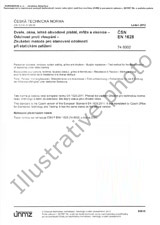We need your consent to use the individual data so that you can see information about your interests, among other things. Click "OK" to give your consent.
ČSN EN ISO 16256-ed.2 (857010)
Clinical laboratory testing and in vitro diagnostic test systems - Broth micro-dilution reference method for testing the in vitro activity of antimicrobial agents against yeast fungi involved in infectious diseases
Translate name
STANDARD published on 1.5.2022
The information about the standard:
Designation standards: ČSN EN ISO 16256-ed.2
Classification mark: 857010
Catalog number: 514195
Publication date standards: 1.5.2022
SKU: NS-1055478
The number of pages: 32
Approximate weight : 96 g (0.21 lbs)
Country: Czech technical standard
Category: Technical standards ČSN
The category - similar standards:
Annotation of standard text ČSN EN ISO 16256-ed.2 (857010):
This document describes a method for testing the susceptibility to antifungal agents of yeasts, including Candida spp. and Cryptococcus neoformans, that cause infections. The reference method described here has not been used in studies of the yeast forms of dimorphic fungi, such as Blastomyces dermatitidis and/or Histoplasma capsulatum variety capsulatum. Moreover, testing filamentous fungi (moulds) introduces several additional problems in standardization not addressed by the current procedure. Those methods are beyond the scope of this document.
This document describes the broth micro-dilution reference method, which can be implemented by either of two pathways. One pathway involves visual determination of MICs (CLSI method)[1][5]; the second pathway involves spectrophotometric determination of MICs (EUCAST method)[2][10]. The MIC reflects the activity of the drug under the described test conditions and can be interpreted for clinical management purposes by taking into account other factors, such as drug pharmacology or antifungal resistance mechanisms. In addition, MIC distributions can be used to define wild type or non-wild type fungal populations. Clinical interpretation of the MIC value is beyond the scope of this document; interpretive category breakpoints specific to the CLSI- and EUCAST-derived methods can be found by consulting the latest interpretive tables provided by the organizations[5][15]. Routine susceptibility testing methods or diagnostic test devices can be compared with this reference method in order to ensure comparable and reliable results for validation or registration purposes
Preview of the standard ČSN EN ISO 16256-ed.2 (857010)
We recommend:
Technical standards updating
Do you want to make sure you use only the valid technical standards?
We can offer you a solution which will provide you a monthly overview concerning the updating of standards which you use.
Would you like to know more? Look at this page.




 Cookies
Cookies
